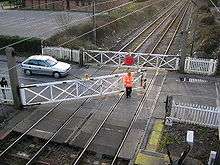Sunshine Coast Line
| Sunshine Coast Line | |
|---|---|
 | |
| Overview | |
| Type | Commuter rail |
| System | National Rail |
| Status | Operational |
| Locale | East of England |
| Termini |
Colchester Clacton-on-Sea Walton-on-the-Naze |
| Stations | 12 |
| Operation | |
| Owner | Network Rail |
| Operator(s) | Abellio Greater Anglia |
| Depot(s) |
Colchester Clacton-on-Sea |
| Rolling stock |
Class 321 Class 360 |
| Technical | |
| Line length | 18 miles 45 chains (29.9 km) |
| Track gauge | 1,435 mm (4 ft 8 1⁄2 in) standard gauge |
| Sunshine Coast Line | ||||||||||||||||||||||||||||||||||||||||||||||||||||||||||||||||||||||||||||||||||||||||||||||||||||||||||||||||||||||||||||||||
|---|---|---|---|---|---|---|---|---|---|---|---|---|---|---|---|---|---|---|---|---|---|---|---|---|---|---|---|---|---|---|---|---|---|---|---|---|---|---|---|---|---|---|---|---|---|---|---|---|---|---|---|---|---|---|---|---|---|---|---|---|---|---|---|---|---|---|---|---|---|---|---|---|---|---|---|---|---|---|---|---|---|---|---|---|---|---|---|---|---|---|---|---|---|---|---|---|---|---|---|---|---|---|---|---|---|---|---|---|---|---|---|---|---|---|---|---|---|---|---|---|---|---|---|---|---|---|---|---|
Legend | ||||||||||||||||||||||||||||||||||||||||||||||||||||||||||||||||||||||||||||||||||||||||||||||||||||||||||||||||||||||||||||||||
| ||||||||||||||||||||||||||||||||||||||||||||||||||||||||||||||||||||||||||||||||||||||||||||||||||||||||||||||||||||||||||||||||
| ||||||||||||||||||||||||||||||||||||||||||||||||||||||||||||||||||||||||||||||||||||||||||||||||||||||||||||||||||||||||||||||||
The Sunshine Coast Line is the current marketing name of what originally was the Tendring Hundred Railway Line, a branch off the Great Eastern Main Line in the East of England. It links Colchester to the seaside resorts of Clacton-on-Sea and, via a branch, Walton-on-the-Naze. The line is part of the Network Rail Strategic Route 7, SRS 07.08, and is classified as a London & South East commuter line.[1] Passenger services on the line are currently operated by Greater Anglia.
Trains for Clacton-on-Sea usually originate at London Liverpool Street, while those for Walton-on-the-Naze typically start at Colchester (or Thorpe-le-Soken on Sundays). There is, however, limited morning and evening peak-time services in each direction between Walton-on-the-Naze and Liverpool Street.
History
Steam era
The Great Eastern Main Line out of Shoreditch in London reached Colchester by 1843 and was extended to Ipswich in 1846.
The first short section of this branch line was built by the Colchester, Stour Valley, Sudbury & Halstead Railway to the port village of Hythe, and opened for freight traffic on 31 March 1847. In 1859 the Tendring Hundred Railway Company was formed to extend the line from Hythe to Wivenhoe, which opened on 8 May 1863 for both passenger and goods services from Colchester. By the time the Wivenhoe extension opened the line had been taken over by the Great Eastern Railway (GER).
The route was extended to Weeley on 8 January 1866, to Kirby Cross on 28 July 1866, and on to the terminus at Walton-on-Naze on 17 May 1867. In the meantime, a short branch to a new station called St. Botolph's, located more centrally in Colchester, opened on 1 March 1866. This station was renamed Colchester Town on 8 July 1991 by British Rail.[2]
A second company, the Wivenhoe & Brightlingsea Railway, had been incorporated in 1861 to build a line from Wivenhoe to Brightlingsea, which opened on 17 April 1866. There were also proposals to build a line to Clacton as early as 1866, but nothing came of them until 1877, when the Clacton-on-Sea Railway was incorporated. The connection from Thorpe-le-Soken to Clacton opened on 4 July 1882, also operated by the GER.
The GER soon negotiated to buy both the Tendring Hundred Railway and the Clacton-on-Sea Railway, and both became part of the GER on 1 July 1883. The Wivenhoe & Brightlingsea company was absorbed by the GER on 9 June 1893.[3]
In 1923 the line (along with the rest of the GER) became part of the London and North Eastern Railway.
A section of the line between Frinton and Walton-on-Naze had to be re-sited in 1929 due to fears of coastal erosion on the original alignment.[4]
Following nationalisation on 1 January 1948, the line became part of the Eastern Region of British Railways.
Electrification

Electrification of the line commenced in the 1950s and by January 1959 the line was electrified as far as Great Bentley. The first trial train to run on the newly electrified section departed Colchester on 18 January 1959. The line was the first in the country to be electrified at 25 kV AC, using overhead wires,[5] with electrified services inaugurated on 13 April 1959.[6] Between 1962 and 1992, services on the line were largely operated by a fleet of Class 309 electric multiple units which were specially designed and constructed for the route. The 309s were replaced on the route by newer rolling stock between 1992 and 1994 during the Network SouthEast era.
Passenger services have been operated by two different franchises since privatisation of British Rail in 1997: First Great Eastern until 31 March 2004, when the National Express Group took over with the company branded as One Railway until February 2008, at which time it was rebranded as National Express East Anglia. It is currently operated by Abellio Greater Anglia, a subsidiary of Nederlandse Spoorwegen.
Recent developments
A £104 million engineering project known as the Colchester to Clacton Resignalling Project took place on the line between December 2006 and July 2009.[7] Life-expired signalling equipment was replaced and a new control system was installed; 170 modern LED signals were installed and eight manual level crossings were upgraded to full barrier crossings with security cameras. The line was closed every weekend and on public holidays, with bus replacement services provided.[8]
There was opposition from the town of Frinton to keep the manual gates, which were reportedly removed "under cover of darkness". Folklore has it that townspeople used to lock the gates to keep out coach-loads of tourists.[9]
Infrastructure
The line is double track except for the branch between Thorpe-le-Soken and Walton-on-the-Naze which is single track. It is electrified at 25 kV AC, has a loading gauge of W6 and a line speed limit of between 30-75 mph. The branch to Colchester Town has a limit of 30 mph.[1]
Passenger train services are formed by electric multiple units, typically Class 321 and Class 360 units. The Walton-on-the-Naze to Colchester local services are typically formed of four carriages. The Clacton-on-Sea to London Liverpool Street services are usually operated as four or eight coaches during the off-peak and either eight or 12 during peak hours.
Services
The typical Monday to Saturday off-peak service on the line is:
- 1 train per hour (tph) between Clacton-on-Sea and London Liverpool Street, calling at Thorpe-le-Soken, Wivenhoe, Colchester, Witham, Chelmsford, Shenfield, Stratford and London Liverpool Street
- 1 tph between Walton-on-the-Naze and Colchester, calling at Frinton-on-Sea, Kirby Cross, Thorpe-le-Soken, Weeley, Great Bentley, Alresford, Wivenhoe, Hythe, Colchester Town and Colchester
- 1 tph between Walton-on-the-Naze and Colchester Town, calling at Frinton-on-Sea, Kirby Cross, Thorpe-le-Soken, Weeley, Great Bentley, Alresford, Wivenhoe, Hythe and Colchester Town
- 1 tph between Colchester and Colchester Town
References
- 1 2 "Route 7 - Great Eastern" (PDF). Network Rail. Retrieved 2009-05-22.
- ↑ Butt, R.V.J. (1995). The Directory of Railway Stations. Yeovil: Patrick Stephens Ltd. pp. 202, 65. ISBN 1-85260-508-1. R508.
- ↑ Walsh, B.D.J. (September 1959). Cooke, B.W.C., ed. "The Great Eastern Line in the Tendring Hundred". The Railway Magazine. Westminster: Tothill Press Ltd. 105 (701): 641.
- ↑ Body, Geoffrey (1986). PSL Field Guide - Railways of the Eastern Region - Vol 1 : Southern operating area. Wellingborough: Patrick Stephens Limited. p. 175. ISBN 0-85059-712-9.
- ↑ Cooke, B.W.C., ed. (June 1959). "High-Voltage Electrification on B.R.". The Railway Magazine. Westminster: Tothill Press Ltd. 105 (698): 369.
- ↑ Cooke, B.W.C., ed. (June 1959). "Clacton and Walton Electrification". The Railway Magazine. Westminster: Tothill Press Ltd. 105 (698): 378.
- ↑ "More reliable railway for Essex as £100m+ upgrade is completed". Network Rail. 2 Sep 2009. Retrieved 8 Sep 2011.
- ↑ "MORE RELIABLE RAILWAY FOR ESSEX AS £100M+ UPGRADE IS COMPLETED". NetworkRail. 2009-09-02. Retrieved 2010-03-29.
- ↑ Booth, Robert (2009-04-20). "Frinton-on-Sea's historic railway gates removed 'under cover of darkness'". The Guardian. London. Retrieved 2010-03-29.
